Diving Safety
-
- SUPSALV & Finding El Faro Maritime Reporter, Jan 2016 #38
Last month we were offered an in-depth discussion on marine salvage with Captain Gregg W. Baumann, U.S. Navy, Director of Ocean Engineering, Supervisor of Salvage and Diving. Captain Baumann and his team have a long history regarding difficult missions accomplished, including most recently the location and filming of the lost TOTE containership El Faro.
What is the scope of the responsibility of the Supervisor of Salvage & Diving; Director of Ocean Engineering?
The responsibilities of the Supervisor of Salvage & Diving; Director of Ocean Engineering (SUPSALV) include being the Center of Excellence for diving for the Department of Defense (DoD), the system safety certification authority for DoD diving and manned hyperbaric equipment, the technical authority for military diving equipment, the technical authority for underwater ship’s husbandry repairs & inspections, and salvage; By authority of the “Salvage Facilities Act” (10 U.S.C. 7361-7364) SUPSALV provides salvage facilities for public and private vessels and provides Admiralty legal support to settle claims for salvage services rendered by the Navy. Within the context of this authority, SUPSALV provides for the equipping and maintenance of a national salvage capability for use in peacetime, war, or national emergency.
I would like to put your office into scope. Please give an overview of the personnel and physical assets under your guidance.
SUPSALV has more than 565 military, civil servants, and full time contracted employees supporting our Washington, District of Columbia headquarters office, our Naval Experimental Dive Unit research laboratory in Panama City, Florida, our deep ocean search and recovery equipment program, our Emergency Ship Salvage Material (ESSM) warehouse system, diving engineering services, and our world-wide, underwater hull cleaning services for fleet vessels. Our facilities include a headquarters office, eight ESSM warehouses and support centers around the world, a Deep Ocean Search and Recovery warehouse and engineering facility in Maryland, and diving services support offices in Virginia, California, Hawaii, Japan, and Bahrain. Our inventory of search equipment, diving support material, oil spill recovery equipment, and spares total more than 30,000 items, more than 500,000 sq. ft. of facilities, and a world class diving and equipment research facility. SUPSALV maintains national mission assets of search and recovery systems with capabilities ranging from shallow water to 20,000 ft. that include the Towed Pinger Locators, towed Side Scan Sonars, and Remotely Operated Vehicles. Additionally, we maintain three worldwide commercial salvage services contracts for which we can immediately surge in personnel and equipment. Our annual average operating budget is approximately $110-120M, but increases significantly when we conduct large reimbursable salvage and oil spill operations. The value of our non-facility related inventory is in excess of $110M.
We understand that you assumed this post in October 2014. A little more than a year into the position, what do you find most rewarding? The most challenging?
What is most rewarding and most challenging is one in the same. Specifically, SUPSALV is the backbone for providing the U.S. Navy fleet with diving support and salvage capabilities as a national level first responder. Providing all of these services on a daily basis so that the Navy fleet can maintain its strong military presence at sea and keeping our sailors, airmen, soldiers, marines, and guardsmen safe is what drives me each and every day. However, meeting all of these challenges with limited budgets and resources, requires making difficult decisions to keep the warfighter prepared and safe while still operating in a difficult fiscal environment. Helping our forces accomplish their missions safely and effectively is the reward for our team’s hard work and diligent efforts.
For this interview, we are interested to focus on salvage and diving safety. Given that scope, could you share a ‘case study’ or two which best exemplifies the capability of your office?
First, I’d site two recent marine incidents. The first is the M/V El Faro which went missing on or about Oct. 1 in the Bahamas. The National Transportation Safety Board (NTSB) in the conduct of their safety investigation deemed they needed SUPSALV’s experience and resources. With our long standing working relationship, we quickly partnered and developed plans to search for, locate, conduct a Side Scan Sonar survey of the accident area, video document the ship, and retrieve the ship’s Voyage Data Recorder (VDR). Utilizing our 20,000 ft. Side Scan Sonar “ORION”, our 20,000 ft. Remotely Operated Vehicle “CURV”, and the Military Sealift Command’s ocean going tug USNS Apache (T-ATF 172) we mobilized and satisfied three of the four objectives within just a few weeks. Unfortunately, we have yet to be able to locate the VDR. The accident is still under investigation with the NTSB and United States Coast Guard.
A second salvage example would be the successful removal of USS Guardian (MCM 5) in 2013. The ship unfortunately ran hard aground on Tubbataha Reef in the Sulu Sea in the Philippines. Due to the sensitive reef environment, the inability to access the vessel with large removal equipment, monsoon weather and seas, SUPSALV brought together a team of navy divers, a navy salvage ship, salvage engineers, and commercial salvors to safely remove the ship from the reef by cutting it up. Balancing environmental concerns, effective salvage plans, and political sensitivities, SUPSALV safely sectioned the ship into four 250-400 ton lifts, and removed the ship without causing any further damage to the reef or allowing the release of pollution or hazardous substances into the environment.
Your job by its inherent nature is a dangerous one. Put the emphasis on safety in perspective.
On diving safety, personnel safety is always the primary consideration. This involves ensuring safety is paramount in both the design of Divers Life Support Systems (DLSS) as well as diving operations themselves. We ensure safety is designed into, tested for and eventually certified in all of our DLSS. Tragically though, we lost four sailors in diving accidents in 2013. As a result, we conducted a strategic assessment of the safety of diving operations throughout the Navy. SUPSALV co-chaired a Diving Operational Assessment Integrated Project Team that conducted a holistic review of Navy Diving Program compliance with requirements with particular focus on supervisor accountability. Integral to this effort was an assessment of the culture within the diving community, as it affects our ability to adequately assess operational readiness, effectively plan missions, accurately apply operational risk management, safely execute dives, and apply lessons learned. The findings of the review found: Navy diving continues to meet Combatant Commander requirements and supervisory accountability, and that navy diving is effective. However, there were specific areas that were deemed to need improvement: improve supervisor decision making, development, qualification, and proficiency; build effectiveness in command level diving assessments; become a self-learning organization; establish better diving mishap reporting and trend analysis; and update the Navy’s diving program instruction.
Marine Salvage is intriguing, literally an engineered solution each time out. In your career, what one technology do you count as having the greatest impact on allowing salvage to be conducted more efficiently and safely?
Unequivocally, it’s the improvements in the area of information technology that have had the greatest impact in our response capability. In most cases the physical rigors of salvage are basic, rudimentary, and don’t have huge strides to make with the increase in technology. However, the software tools now immediately available to the salvor are game changers. The software packages available today have the capability to rapidly perform very detailed and complex analyses of vessel loading, stability, and structural characteristics for intact, damaged, and grounded vessels and evaluate these properties over the full range of salvage operations. Within SUPSALV, we use a Navy unique software package, Program of Ship Salvage Engineering or “POSSE” for short. As IT systems continued to grow, SUPSALV teamed with a commercial vendor to jointly fund and develop POSSE. It has given us the ability to fully model every ship in the Navy inventory. As a result, when a salvage incident does arise, within minutes we have our engineers conducting risk assessments, developing salvage plans, and providing understandable engineering solutions to complex, and multi-variable problems.
When we speak to commercial salvors, most cite the increasing size of ships as one of their top challenges today. How is the market changing to present challenges to your office?
As it relates to SUPSALV’s participation in the salvaging of commercial vessels, the increased size of ships is certainly at the top of the list of challenges. However, as it relates to SUPSALV’s overall salvage operations, it’s the increased focus on minimizing damage to the environment and pollution discharges while conducting the salvage.
As a result SUPSALV regularly conducts spill exercises with the fleet, provides on-going hands on and table top training, and maintains one of the largest oil spill equipment repositories around the world in our ESSM system.
We cover Navy and Government vessels in our pages regularly, and to say current government spending is “challenged” is an understatement. From where you sit, what are your funding issues, if any, and how has this had a material impact on your service.
The center focus of the Navy budget every year is shipbuilding and the 30 year shipbuilding plan. Since the Cold War ended, the Navy’s inventory of ships has dwindled and replacement with more complex technologies has become more expensive for the same size of vessel. As a result, finding the right balance of ships in the 30 year shipbuilding plan has become increasingly challenging. Our current inventory of four tugs and four salvage ships is aging and will require replacement in the not too distant future. How the Navy will replace this capability to meet the fleet mission requirements is still being discussed.
Looking at your career, explain in as much detail as possible the most difficult or challenging dive or salvage operation, explaining why.
The operation that clearly stands out the most to me is the salvaging of the Japanese high school training fishing vessel, F/V Ehime Maru, and recovering eight of the nine souls lost off the coast of Hawaii in 2000 ft. In 2001, one of our submarines tragically hit and sunk the Ehime Maru during a routine training exercise. Showing true sorrow and good will to the Japanese families who lost loved ones in the incident, President Bush promised to do everything possible to recover those who were lost. In looking at the possible solutions at this depth, we came up with few alternatives. At 2000 feet, we couldn’t find anyone certified to conduct saturation dives to this depth. We then looked at the idea of penetrating the ship with ROV’s. This option was ruled out due to the high probability of ROV entanglement and inability to access the entire interior of the vessel. The solution we eventually arrived at was to place two straps beneath the ship, lift and suspend the ship beneath a ship on the surface, then carry it to shallow water where we could safely and effectively dive on it. A salvage of this nature had never been accomplished before so we were developing innovative solutions as the operation progressed. To obtain expertise conducting complex operations at this depth, we turned to the deep ocean oil field support companies.
Teaming with a handful of these companies and a commercial salvor, we successfully placed two straps underneath the ship and brought the ship into a depth where we could dive on it.
This operation was by far the most difficult in my career due to the depth of recovering the ship and use of ROV’s to do so, the political sensitivities involved between the two governments, the cultural sensitivities involved, the Sept. 11, 2001 terrorist attacks taking place while recovering the ship, and most importantly the human compassion involved in trying to help the nine families. In the end we were only successful in locating and recovering eight of those lost. In the 29 years I’ve served in the Navy, the memory that has etched itself the deepest in me was notifying the family of the 9th victim that we were unable to locate their teenage son.Captain Gregg W. Baumann
Director of Ocean Engineering, Supervisor of Salvage and Diving
Captain Baumann is a native of Vestal, NY. He graduated from Clarkson University in 1986 with a Bachelors of Science in Chemical Engineering. Following graduation, he joined the Navy and was commissioned in 1987 through Officer Candidate School in Newport, RI. Baumann also earned a Master’s of Science in Mechanical Engineering from the Naval Post Graduate School and completed the Total Ship’s Systems Engineering (TSSE) program at the Naval Postgraduate School in Monterey, CA.
Baumann’s first assignment was aboard USS Gridley (CG 21) serving as the Electronic Warfare Officer, Boiler’s Officer, and the Ship’s Material Maintenance Officer. Following sea tour, Baumann was selected to Engineering Duty Officer and completed training at the Naval Diving and Salvage Training Center, in Panama City, FL.
As an engineering duty officer, Baumann served as: Project Officer to the detachment of the Supervisor of Shipbuilding (SUPSHIP), New Orleans for numerous Navy, Marine Corps, and Foreign Military Sales small craft new construction contracts; Production Officer for MCM repair availabilities and tasked with standing up a new SUPSHIP New Orleans repair detachment; Production Officer and Diving Officer at the Navy’s Ship Repair Facility (SRF) in Sasebo, Japan; and Assistant for Salvage in NAVSEA’s Office of the Supervisor of Diving & Salvage. During this tour, Baumann was the salvage engineer for many diving and salvage operations including the salvaging of the sunken Japanese fishing trawler off Pearl Harbor, Ehime Maru, the grounded USS LaMoure County (LST 1194) off the coast of Chile, and the oil recovery from the sunken USS Mississinewa (AO 59) in Ulithi Atoll, Federated States of Micronesia.
Captain Baumann continued his career with tours as the Engineering Duty Officer Detailer and Community Manager, Navy’s Bureau of Personnel; DDG 51 Program Manager’s Representative, Supervisor of Shipbuilding Bath, ME; Chief of Staff for the Deputy Assistant Secretary of the Navy for Ship programs and the Executive Assistant to the Assistant Secretary of the Navy for Research, Development, and Acquisition (ASN RD&A) at the Pentagon. In 2010, he was assigned as the Program Manager for the International Fleet Support Programs Office (PMS 326) within NAVSEA’s Surface Warfare Directorate (SEA 21) where he was responsible for multiple projects in excess of $5B that provided ships, weapon systems, and life cycle support equipment to more than 40 foreign partners. Captain Baumann assumed command from CAPT Mark Matthews as the Director of Ocean Engineering, Supervisor of Salvage and Diving in October 2014. In this role, he is responsible for all aspects of ocean engineering for the U.S. Navy, including salvage, in-water ship repair, contracting, towing, diving safety, and equipment maintenance and procurement. Baumann has earned a Legion of Merit (w/ gold star), Meritorious Service Medal (w/ four gold stars), Navy and Marine Corps Commendation Medal (w/ two gold stars), and the Navy and Marine Corps Achievement Medal.The feature El Faro spot aired on CBS on Sunday, January 3, 2016. If you missed it, view the 60 Minutes video here:http://www.cbsnews.com/videos/lost-in-the-bermuda-triangle
(As published in the January 2016 edition of Maritime Reporter & Engineering News - http://magazines.marinelink.com/Magazines/MaritimeReporter)
-
- SUPSALV & Finding El Faro Marine Technology, Jan 2016 #18
is the reward for our team’s hard work and diligent efforts. For the context of this interview, we are most interested to focus on salvage and diving safety. Given that scope, could you share with our readers a ‘case study’ or two which you feel best exemplifies the capability of your office? First
-
- Diving And Insurance Symposium Scheduled Nov. 14-15 In New York Maritime Reporter, Aug 15, 1977 #46
, 1977. The purpose of the Symposium is to provide a common forum for the mutual interchange of information on technical developments affecting diving safety standards and insurance rates within the American diving industry. The Symposium is being sponsored by the Association of Diving Contractors
-
- Congressman Mario Biaggi Will Address First N.Y.C. Diving-Insurance Symposium Maritime Reporter, Nov 1977 #71
Diving and Insurance Symposium, scheduled for November 14- 15, 1977 at the Statler Hilton, will focus on technical developments affecting diving safety standards and insurance rates within the American diving industry. The Symposium, sponsored by the Maritime Association of the Port of New
-
- Partnerships Producing Game Changing Safety Innovations Marine Technology, Apr 2013 #16
for safe operation,” said Ryan Vestal, Engineering Manager Well Services. Another sign of this trend is the recently formed U.S./Gulf of Mexico Diving Safety Work Group (DSWG). A first-of-its-kind alliance between operators and contractors for the purpose of advancing safety in Gulf diving operations
-
 )
March 2024 - Marine Technology Reporter page: 38
)
March 2024 - Marine Technology Reporter page: 38LANDER LAB #10 Photo courtesy West Mountain Radio Photo courtesy of Clarios/AutoBatteries.com Figure 6 The West Mountain Radio Computerized Battery Analyzer (CBA V) attaches to a Figure 5 laptop by a USB-B cable, and to a battery by Powerpole® Connectors. Exploded view of an AGM lead-acid battery.
-
 )
March 2024 - Marine Technology Reporter page: 36
)
March 2024 - Marine Technology Reporter page: 36submersible and ocean lander DOV MIKE demon- can be exposed to high ambient pressure, and can be mounted strated the practicality of this approach, diving the Challenger outside the hull, as was done on the bathyscaph DSV Trieste Deep in the Mariana Trench using PBOF, BMS-protected lith- in the early
-
 )
March 2024 - Marine Technology Reporter page: 11
)
March 2024 - Marine Technology Reporter page: 11assist in identifying mines and act as a neutralization device. About the Author Bottom mines pose even greater chal- David R. Strachan is a defense analyst and founder of lenges. Unlike contact mines, bottom Strikepod Systems, a research and strategic advisory mines utilize a range of sensors to
-
 )
March 2024 - Marine Technology Reporter page: 6
)
March 2024 - Marine Technology Reporter page: 6master and doctoral degrees from that opened the hadal depths to routine exploration. He writes Scripps Institution of Oceanography. for the Journal of Diving History and the MTR. Authors & Contributors Konowe Quinn Konowe Celia Konowe is from Reston, Va., and has a bachelor’s degree in environmental studies
-
 )
April 2024 - Maritime Reporter and Engineering News page: 42
)
April 2024 - Maritime Reporter and Engineering News page: 42OPINION: The Final Word Seeing the Ship as a System Shipping must engage with the decarbonization realities that lie ahead by changing the way it crafts maritime legislation to re? ect its place in the interconnected, interdependent world economy, said Eero Lehtovaara, ABB Marine & Ports. ABB Marine &
-
 )
April 2024 - Maritime Reporter and Engineering News page: 41
)
April 2024 - Maritime Reporter and Engineering News page: 41Nautel provides innovative, industry-leading solutions speci? cally designed for use in harsh maritime environments: • GMDSS/NAVTEX/NAVDAT coastal surveillance and transmission systems • Offshore NDB non-directional radio beacon systems for oil platform, support vessel & wind farm applications
-
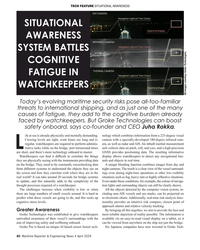 )
April 2024 - Maritime Reporter and Engineering News page: 40
)
April 2024 - Maritime Reporter and Engineering News page: 40TECH FEATURE SITUATIONAL AWARENESS SITUATIONAL AWARENESS SYSTEM BATTLES COGNITIVE FATIGUE IN WATCHKEEPERS All images courtesy Groke Technologies Today’s evolving maritime security risks pose all-too-familiar threats to international shipping, and as just one of the many causes of fatigue, they add
-
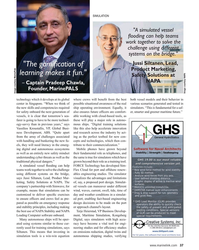 )
April 2024 - Maritime Reporter and Engineering News page: 37
)
April 2024 - Maritime Reporter and Engineering News page: 37SIMULATION "A simulated vessel ? ooding can help teams work together to solve the challenge using different systems on the bridge." – Jussi Siltanen, Lead, "The gami? cation of Product Marketing, learning makes it fun." Safety Solutions at NAPA – Captain Pradeep Chawla, Founder, MarinePALS Image
-
 )
April 2024 - Maritime Reporter and Engineering News page: 35
)
April 2024 - Maritime Reporter and Engineering News page: 35SIMULATION e have a close relationship with tech- Realism is prized beyond immersive, photo-realistic visu- nology, evidenced by, for example, als, and providers are introducing increasingly accurate func- the phones we are estimated to un- tionality. FORCE Technology’s upcoming DEN-Mark2 math- lock around
-
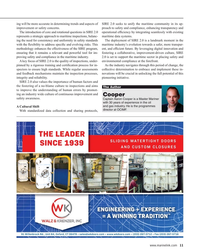 )
April 2024 - Maritime Reporter and Engineering News page: 11
)
April 2024 - Maritime Reporter and Engineering News page: 11ing will be more accurate in determining trends and aspects of SIRE 2.0 seeks to unify the maritime community in its ap- improvement or safety concerns. proach to safety and compliance, enhancing transparency and The introduction of core and rotational questions in SIRE 2.0 operational ef? ciency by
-
 )
April 2024 - Maritime Reporter and Engineering News page: 10
)
April 2024 - Maritime Reporter and Engineering News page: 10Maritime Safety © Roman/AdobeStock SIRE 2.0: Navigating the New Horizon of Maritime Safety By Captain Aaron Cooper, Programs Director, OCIMF he maritime industry is on the cusp of a signi? cant preparing vessel operators and vessel assurance teams for the transformation with the launch of the Ship
-
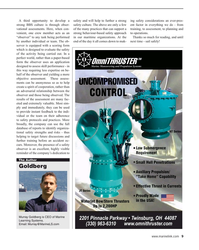 )
April 2024 - Maritime Reporter and Engineering News page: 9
)
April 2024 - Maritime Reporter and Engineering News page: 9A third opportunity to develop a safety and will help to further a strong ing safety considerations an ever-pres- strong BBS culture is through obser- safety culture. The above are only a few ent factor in everything we do - from vational assessments. Here, when con- of the many practices that can
-
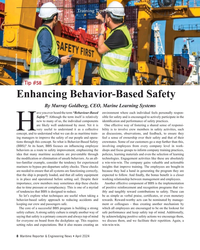 )
April 2024 - Maritime Reporter and Engineering News page: 8
)
April 2024 - Maritime Reporter and Engineering News page: 8Training Tips for Ships © By tuastockphoto/AdobeStock Tip #58 Enhancing Behavior-Based Safety By Murray Goldberg, CEO, Marine Learning Systems ave you ever heard the term “Behaviour-Based environment where each individual feels personally respon- Safety”? Although the term itself is relatively sible for
-
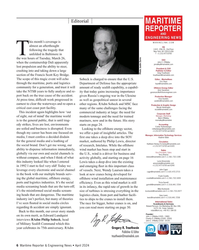 )
April 2024 - Maritime Reporter and Engineering News page: 6
)
April 2024 - Maritime Reporter and Engineering News page: 6Editorial MARITIME REPORTER AND ENGINEERING NEWS his month’s coverage is M A R I N E L I N K . C O M almost an afterthought HQ 118 E. 25th St., 2nd Floor following the tragedy that New York, NY 10010 USA T +1.212.477.6700 Tunfolded in Baltimore in the wee hours of Tuesday, March 26, CEO John C.
-
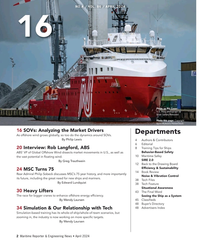 )
April 2024 - Maritime Reporter and Engineering News page: 2
)
April 2024 - Maritime Reporter and Engineering News page: 2NO.4 / VOL. 86 / APRIL 2024 16 Photo on the Cover: U.S. Navy photograph by Brian Suriani/Released Photo this page: Copyright Björn Wylezich/AdobeStock 16 SOVs: Analyzing the Market Drivers Departments As offshore wind grows globally, so too do the dynamics around SOVs. By Philip Lewis 4 Authors & Contribut
-
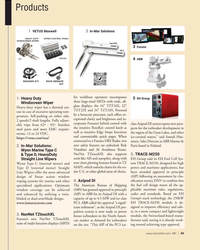 )
April 2024 - Marine News page: 43
)
April 2024 - Marine News page: 43Products 1 2 VETUS Maxwell In-Mar Solutions 3 Furuno ABB 4 for workboat operators encompasses EH Group 1. Heavy Duty 5 three large-sized MFDs with wide, all- Windscreen Wiper glass displays: the 16” TZT16X, 22” Heavy-duty wiper has a thermal cut- TZT22X and 24” TZT24X. Powered out in
-
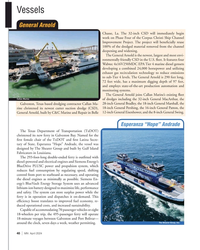 )
April 2024 - Marine News page: 40
)
April 2024 - Marine News page: 40Vessels General Arnold Chasse, La. The 32-inch CSD will immediately begin work on Phase Four of the Corpus Christi Ship Channel Improvement Project. The project will bene? cially reuse 100% of the dredged material removed from the channel deepening and widening. The General Arnold is the newest,
-
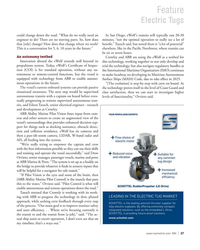 )
April 2024 - Marine News page: 37
)
April 2024 - Marine News page: 37Feature Electric Tugs could change down the road. “What do we really need an In San Diego, eWolf’s transits will typically run 20-30 engineer to do? There are no moving parts. So, how does minutes, “not the optimal operation to really see a lot of that [role] change? How does that change where we work?
-
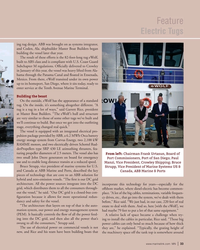 )
April 2024 - Marine News page: 33
)
April 2024 - Marine News page: 33Feature Electric Tugs ing tug design. ABB was brought on as systems integrator, and Coden, Ala. shipbuilder Master Boat Builders began building the vessel later that year. The result of these efforts is the 82-foot-long tug eWolf, built to ABS class and is compliant with U.S. Coast Guard Subchapter M
-
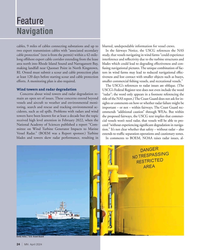 )
April 2024 - Marine News page: 24
)
April 2024 - Marine News page: 24Feature Navigation cables, 9 miles of cables connecting substations and up to blurred, undependable information for vessel crews. two export transmission cables with “associated secondary In the fairways Notice, the USCG references the NAS cable protection” (text is from the permit) within a 42-mile-
-
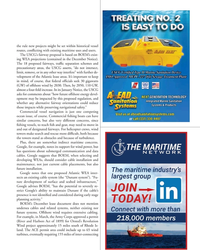 )
April 2024 - Marine News page: 23
)
April 2024 - Marine News page: 23the rule new projects might be set within historical vessel routes, con? icting with existing maritime uses and users. The USCG’s fairway proposal is based on BOEM’s exist- ing WEA projections (contained in the December Notice). The 18 proposed fairways, traf? c separation schemes and precautionary
-
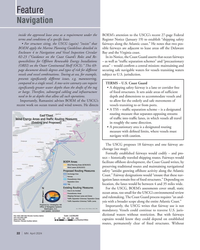 )
April 2024 - Marine News page: 22
)
April 2024 - Marine News page: 22Feature Navigation inside the approved lease area as a requirement under the BOEM’s attention to the USCG’s recent 27-page Federal terms and conditions of a speci? c lease. Register Notice (January 19) to establish “shipping safety • For structure siting, the USCG (again) “insists” that fairways along
-
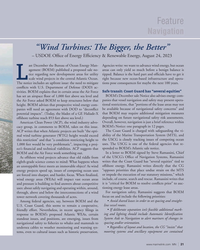 )
April 2024 - Marine News page: 21
)
April 2024 - Marine News page: 21Feature Navigation “Wind Turbines: The Bigger, the Better” – USDOE Of? ce of Energy Ef? ciency & Renewable Energy, August 24, 2023 ast December the Bureau of Ocean Energy Man- Agencies write: we want to advance wind energy, but ocean agement (BOEM) published a proposed sale no- areas can only yield so
-
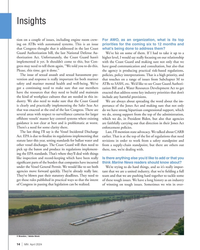 )
April 2024 - Marine News page: 14
)
April 2024 - Marine News page: 14Insights tion on a couple of issues, including engine room crew- For AWO, as an organization, what is its top ing on ATBs with automated systems. This is an issue priorities for the coming six to 12 months and that Congress thought that it addressed in the last Coast what’s being done to address them? Gua
